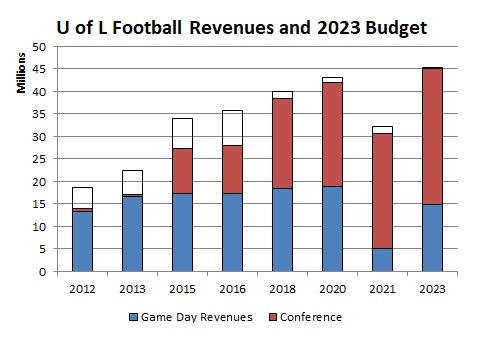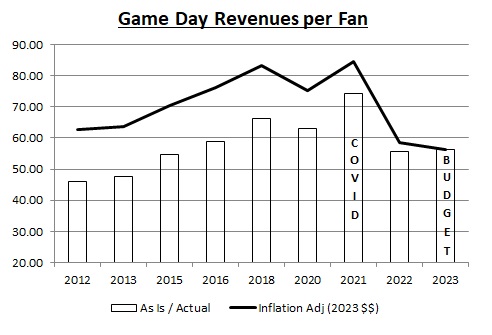I want to thank one of my buds from the premium side, @CARDOMYTE, for motivating me on this particular thread. Those guys are the best, and I encourage anyone who is not a premium member to consider joining for the very modest cost.
U of L's annual financial reports do not contain the breakdown on football revenues included in the following discussion. These numbers are only found in the monthly reports that the ULAA prepares internally. The reasons I have these numbers for most of the last decade is that lately I have asked for them, and previously, I had some on file from the annual budgets. A few data points are missing or omitted, but they don't subtract from the conclusions that result.
There's also a couple revenue terms I need to describe... "Conference" is currently the combined revenue streams of ACC Media and ACC Revenue Distribution. Of course, before the ACC, it was whatever revenue came from the Big East or AAC in similar categories. There's also a grouping I call "Game Day Revenues" (GDR). That's the sum of Ticket Sales, Suite Rentals, Loge Seats, Parking, and Concessions from the revenue statements, if they show up explicitly.
And 2021 was the year affected by Covid.
Here's the breakdown in football revenue for the years in which I have data on file. Revenues since 2015 in this series were significantly increased by the ACC revenue streams. I will have the 2022 data point in a few weeks when the 2022 distribution from the ACC is reported in the June 30 monthly report. U of L is expecting the conference revenue to be about $26-1/2 million and the total revenue for 2022 to end up around $48 million.
Note that all of these years are FISCAL years. For example, the 2020 football season (Covid) was played in FY2021.
 There was one extra home game (7) in 2022 than we normally have on the schedule. Also, U of L received almost $5 million for the Chick-fil-A game with Ole Miss. GDR was obviously much less in 2021 when only around ten thousand fans could attend each home game.
There was one extra home game (7) in 2022 than we normally have on the schedule. Also, U of L received almost $5 million for the Chick-fil-A game with Ole Miss. GDR was obviously much less in 2021 when only around ten thousand fans could attend each home game.
There are factors affecting football revenues that some argue are outside of U of L's control. A big positive one is the conference revenue which now represents two-thirds of overall revenue. Besides fielding a competitive football team to play other ACC teams, U of L is not directly making that number happen. We're just a huge beneficiary. Other explanations I hear are declining attendance nationally, U of L scandals and mismanagement, etc. IMO some of those may have substance, but most do not.
I'm focusing now on the blue segments in the above bar chart. Visually the trend in GDRs is flat to rolling over. And to analyze that trend, I folded in home game attendance for the years shown. Ex-Covid, total attendance ranged from 277 thousand in 2018 to 350 thousand in 2013. Without checking, I'm confident there was one more or less home game than the normal complement of six games that in part explains those extremes.
I divided GDR for the season by total attendance to get a GDR per fan. This is how much revenue on game day that U of L is able to extract from the average fan in the stadium. For the upcoming season, I'm using the same average attendance we had this past season (43,966) for seven games and ratio-ing the total down for one less game. The bars are the actual numbers, and the line above them is the inflation adjusted number in 2023 dollars. I applied a guesstimate of 5% inflation for 2023.
 The Covid year was and should have been the highest. That was the most lucrative 20-25% of the fanbase in attendance. For example, I recall there was no attendance restriction in the suites. And there were few individual game tickets sold which is where the discounting and promotions occur.
The Covid year was and should have been the highest. That was the most lucrative 20-25% of the fanbase in attendance. For example, I recall there was no attendance restriction in the suites. And there were few individual game tickets sold which is where the discounting and promotions occur.
Again, you can see the trend overall... Actual GDR per fan was up 44% from 2012 to 2018 and has declined 15% since. Of course, a good part of that 44% increase was inflation. If you adjust for that, the increase was 33% from 2012 to 2018. However, the 2023 budget is for game day revenues to be down 32% from 2018. adjusting for inflation, and on a per fan basis.
Expressing game day revenue per fan gets past the macro issue of declining attendance. Staging football games is central to U of L football operations as far as revenue is concerned. And U of L is getting far less money from its core operations than it did five years ago. The only question now is why. And my hunch is that football has taken a major hit in the more lucrative part of its fanbase. They can get ten thousand of those people in the stadium as evidenced by Covid, but perhaps not many more than that...
U of L's annual financial reports do not contain the breakdown on football revenues included in the following discussion. These numbers are only found in the monthly reports that the ULAA prepares internally. The reasons I have these numbers for most of the last decade is that lately I have asked for them, and previously, I had some on file from the annual budgets. A few data points are missing or omitted, but they don't subtract from the conclusions that result.
There's also a couple revenue terms I need to describe... "Conference" is currently the combined revenue streams of ACC Media and ACC Revenue Distribution. Of course, before the ACC, it was whatever revenue came from the Big East or AAC in similar categories. There's also a grouping I call "Game Day Revenues" (GDR). That's the sum of Ticket Sales, Suite Rentals, Loge Seats, Parking, and Concessions from the revenue statements, if they show up explicitly.
And 2021 was the year affected by Covid.
Here's the breakdown in football revenue for the years in which I have data on file. Revenues since 2015 in this series were significantly increased by the ACC revenue streams. I will have the 2022 data point in a few weeks when the 2022 distribution from the ACC is reported in the June 30 monthly report. U of L is expecting the conference revenue to be about $26-1/2 million and the total revenue for 2022 to end up around $48 million.
Note that all of these years are FISCAL years. For example, the 2020 football season (Covid) was played in FY2021.

There are factors affecting football revenues that some argue are outside of U of L's control. A big positive one is the conference revenue which now represents two-thirds of overall revenue. Besides fielding a competitive football team to play other ACC teams, U of L is not directly making that number happen. We're just a huge beneficiary. Other explanations I hear are declining attendance nationally, U of L scandals and mismanagement, etc. IMO some of those may have substance, but most do not.
I'm focusing now on the blue segments in the above bar chart. Visually the trend in GDRs is flat to rolling over. And to analyze that trend, I folded in home game attendance for the years shown. Ex-Covid, total attendance ranged from 277 thousand in 2018 to 350 thousand in 2013. Without checking, I'm confident there was one more or less home game than the normal complement of six games that in part explains those extremes.
I divided GDR for the season by total attendance to get a GDR per fan. This is how much revenue on game day that U of L is able to extract from the average fan in the stadium. For the upcoming season, I'm using the same average attendance we had this past season (43,966) for seven games and ratio-ing the total down for one less game. The bars are the actual numbers, and the line above them is the inflation adjusted number in 2023 dollars. I applied a guesstimate of 5% inflation for 2023.

Again, you can see the trend overall... Actual GDR per fan was up 44% from 2012 to 2018 and has declined 15% since. Of course, a good part of that 44% increase was inflation. If you adjust for that, the increase was 33% from 2012 to 2018. However, the 2023 budget is for game day revenues to be down 32% from 2018. adjusting for inflation, and on a per fan basis.
Expressing game day revenue per fan gets past the macro issue of declining attendance. Staging football games is central to U of L football operations as far as revenue is concerned. And U of L is getting far less money from its core operations than it did five years ago. The only question now is why. And my hunch is that football has taken a major hit in the more lucrative part of its fanbase. They can get ten thousand of those people in the stadium as evidenced by Covid, but perhaps not many more than that...
Last edited:

